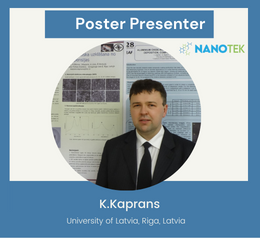Scholars Frontiers in
Nanoscience and Nanotechnology Congress
THEME: "Fostering Advancements in Nanoscience and Nanotechnology"
 27-28 Mar 2023
27-28 Mar 2023  Crowne Plaza Ealing, London, UK & Online
Crowne Plaza Ealing, London, UK & Online THEME: "Fostering Advancements in Nanoscience and Nanotechnology"
 27-28 Mar 2023
27-28 Mar 2023  Crowne Plaza Ealing, London, UK & Online
Crowne Plaza Ealing, London, UK & Online 
Institute of Solid State Physics, University of Latvia, Riga, Latvia
Synergistic Behaviour of TiO2/?-Fe2O3/CNTf Ternary Nanocomposite as Anode for Lithium-Ion Battery
Researcher
in the Laboratory of Materials for Energy Harvesting and Storage, the Institute
of Solid State Physics, University of Latvia (ISSP UL), and has been a is part
of the scientific staff of ISSP since 2014. The main research areas are thin
film electrodes for lithium - ion batteries and synthesis of new composite
materials for renewable energy sources. He has participated in various local
projects related to material science; and is an author of 7 scientific
publications. The fields of specialization include nanomaterials physics,
material science, solid state ionics, methods for electrochemical
investigation, materials for energy storage.
Lithium-ion batteries (LJBs) as one of the most important energy
storage devices, have attracted large attention due to their advantages of high
energy density, long cycle life and rate capability. However, the practical
application of LIBs is still restricted, especially in electrical devices and
hybrid electric vehicles. Electrode materials are key factors to affect the
battery performance as energy storages device [1].
In this research hematite phase iron oxide, anatase phase titanium
dioxide and functionalized carbon
nanotubes composite (CNTf) used as LIBs anode. Iron oxide has high gravimetric
capacity, titanium dioxide has exellent chemical stability and (CNTf) work as a
good electrone conductive network. Different quantitative content of transition
metal oxide in the electrode films are investigated. To estimate battery
performance: cyclability, rate capability, cyclic voltammetry and electrical
impedance spectroscopy are used. Results obtained in this research can be
useful for future investigations of ternary electrode material for energy
storage devices.
The financial support of Strengthening of the capacity of doctoral studies at the
University of Latvia within the framework of the new doctoral model”,
identification No. 8.2.2.0/20/I/006 is greatly acknowledged.